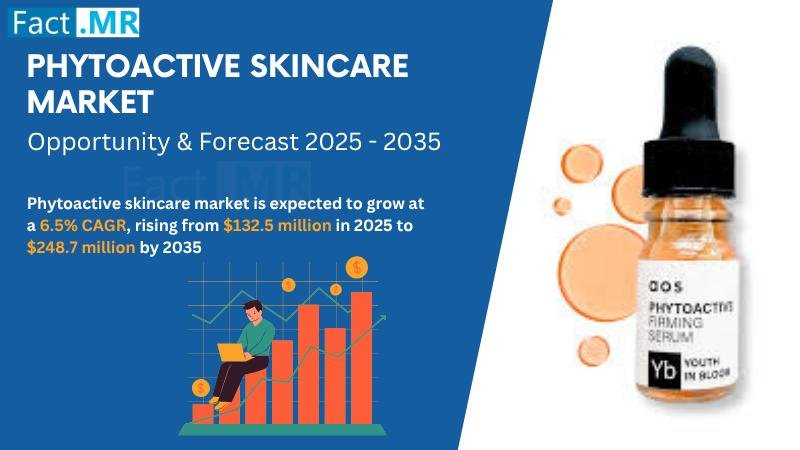Phytoactive Skincare Market Set to Skyrocket: From $132.5 Million to $248.7 Million by 2035
The Phytoactive Skincare Market is gearing up for remarkable growth in the upcoming years. As per recent findings by Fact.MR, this sector is anticipated to surge from an estimated $132.5 million in 2025 to an astounding $248.7 million by 2035. This growth marks a significant compound annual growth rate (CAGR) of 6.5%. Several factors are driving this trend, particularly the consumer shift towards natural skincare and innovative botanical formulations.
The Shift Towards Clean Beauty
Key Motivators
- Consumer Awareness: Growing knowledge about the side effects of chemical-based products is prompting consumers to seek out safer alternatives.
- Natural Ingredients: Phytoactive solutions derived from plant extracts offer beneficial properties such as antioxidants and anti-aging effects.
- Sustainability Focus: Increasingly eco-aware consumers prefer products that are organic and ethically sourced.
The demand for phytoactive skincare products aligns perfectly with the wellness trends adopted by millennials and Gen Z. These demographics are particularly keen on brands that reflect their values of health and sustainability.
Sustainability and Regulation Driving Trends
The rise in eco-consciousness marks a significant trend within the skincare industry. Consumers are now prioritizing:
- Organic Certifications: Many are opting for products with clear ingredient sourcing and no artificial components.
- Regulatory Compliance: With stricter regulations in North America and the EU against harmful chemicals, companies are encouraged to integrate botanical actives in their offerings. This trend is projected to create a revenue potential of $116.2 million between 2025 and 2035.
Innovations in Technology
Technological advancements in extraction and formulation processes are revolutionizing the phytoactive skincare sector. These innovations include:
- Encapsulation Techniques: Enhances the delivery and efficacy of plant-based ingredients.
- Nanotechnology: Allows for deeper penetration of active compounds into the skin.
Countries like Japan and South Korea exemplify the merging of ancient herbal medicine with modern technology, significantly influencing consumer preferences in the region.
Regional Insights: Who’s Leading the Charge?
North America vs. Asia
-
North America: Expected to hold a 9% market share by 2035. This market is characterized by a tech-savvy consumer base keen on scientific-backed phytoactive products. The U.S. alone is projected to provide an absolute dollar opportunity of $32.2 million during the forecast period.
- Asia: East Asia is at the forefront of the phytoactive skincare revolution due to its historical reliance on herbal medicine. This region is showing robust growth, blending traditional knowledge with innovative skincare solutions.
Key Consumer Trends Shaping the Market
- Eco-Conscious Choices: Brands focusing on sustainability and ethical sourcing are increasingly preferred by consumers.
- Skin Sensitivity: Reports of pollution-linked skin issues highlight a growing demand for gentle, plant-based solutions.
- Scientific Backing: Brands that invest in clinical validation for their products are gaining consumer confidence and market share.
- Wellness-Centric Products: As holistic health gains traction, phytoactive offerings aligned with a clean beauty philosophy are becoming increasingly popular.
Challenges Ahead and Opportunities for Growth
The phytoactive skincare market, while poised for success, is not without challenges. Factors such as:
- High Organic Ingredient Costs
- Regulatory Compliance Needs
Despite these challenges, there are significant opportunities for innovation. Developing specialized product lines, such as anti-pollution skincare, can cater to the urban consumer’s unique needs.
The Impact of E-Commerce and Social Media
The evolution of e-commerce and social media platforms has made phytoactive products more accessible than ever. Influencers and online engagement are amplifying brand visibility, especially among younger, digitally savvy consumers.
Competitive Landscape: Not Just Big Players
Both established brands and new entrants are competing in the phytoactive skincare market. Noteworthy developments include:
- Tata Harper’s introduction of the Superkind Calming Crème, designed specifically for sensitive skin.
- Enhanced investments in R&D to create innovative botanical actives.
Market Segmentation Overview
Understanding the market’s structure is crucial for stakeholders. Here’s a breakdown:
- By Product Type: Includes creams, serums, and cleansers, with serums gaining rapid popularity.
- By Application: Key areas are anti-aging, hydration, and acne treatment; anti-aging is expected to see significant growth.
- By End User: Women dominate, but men’s skincare is emerging rapidly.
- By Region: North America and Asia are leading markets.
Looking Ahead: The Future of Phytoactive Skincare
The future of the phytoactive skincare market looks bright, fueled by consumers prioritizing natural and sustainable skincare solutions. Continuous integration of AI-driven personalization and smart beauty technologies will enhance consumer experiences. With the market projected to reach $248.7 million by 2035, it’s safe to say that phytoactive skincare is a lucrative segment of the global beauty industry.
For more insights into this evolving market, explore the full report by Fact.MR. Get involved in the beauty revolution today!


